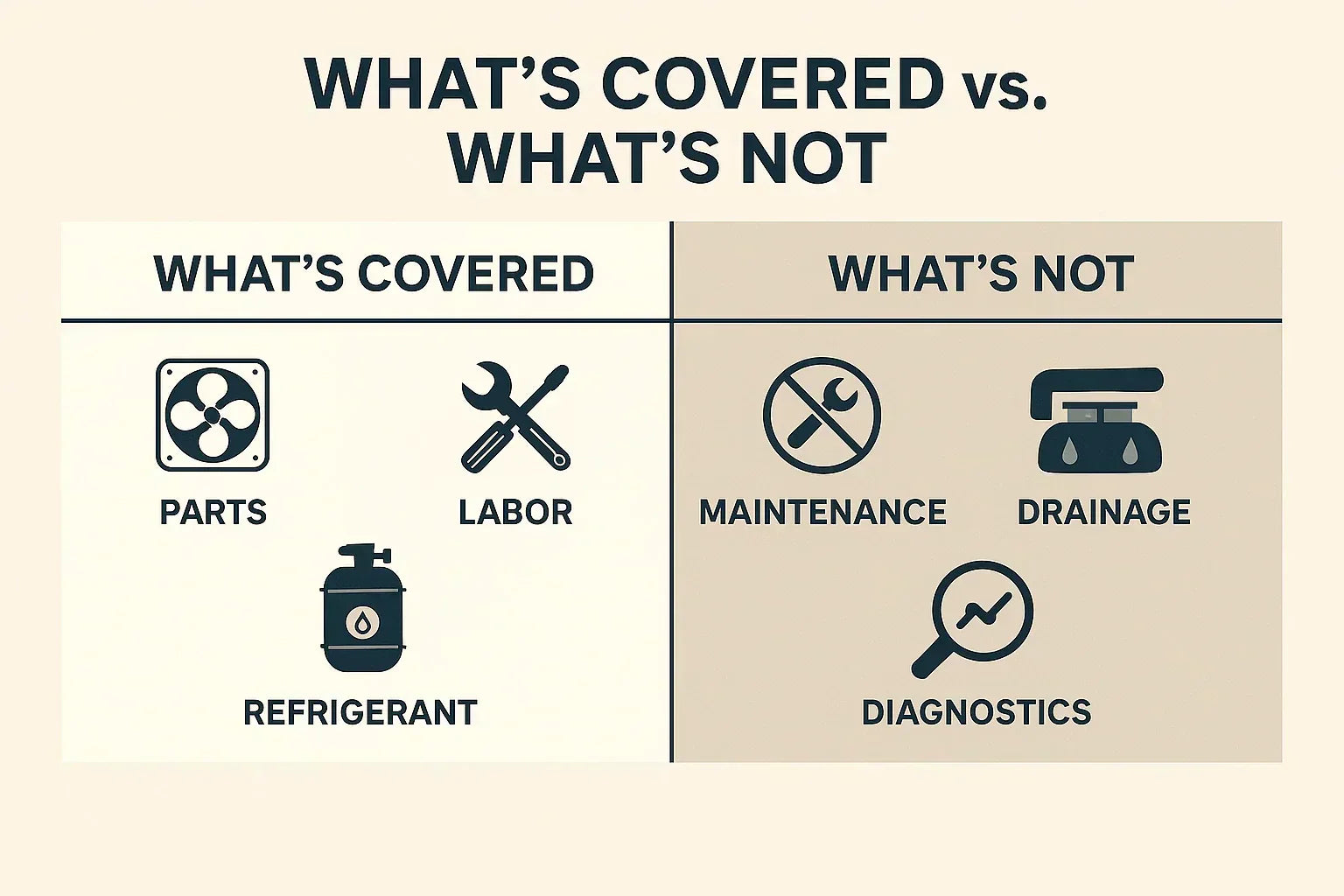If you’ve ever had an unexpected HVAC breakdown and thought, “Isn’t that supposed to be covered under warranty?”—you’re not alone.
Central AC warranties are one of the most misunderstood parts of buying a cooling system. They can protect you from expensive repairs, but only if you understand what’s actually included—and what fine print could void your coverage.
In this guide, we’ll break down the different types of AC warranties, what’s typically covered (and what’s not), how major brands compare in 2025, and how to protect yourself from costly surprises.
🔗 Related: Top 10 Central AC Units Compared
Types of Central AC Warranties
Not all warranties are created equal. When you buy a new central air conditioner, you may be getting multiple layers of protection—but they each come with limitations.
Manufacturer’s Limited Warranty
This is the most common and comes standard with nearly all new systems. Most cover defective parts like the compressor, coils, or fan motors for 5 to 10 years—but not labor. If a part fails, you won’t pay for the component, but you might pay $500–$1,000 in labor to replace it.
📘 Trane’s warranty guide explains how their standard warranty works, what’s included, and when extended labor coverage is available.
Extended Warranties (Manufacturer or Dealer-Sold)
Many brands or dealers offer extended warranty plans that stretch coverage to 12–15 years, and may optionally include labor. These can be worth it if you:
-
Live in a hot climate with long cooling seasons
-
Want peace of mind on expensive components
-
Don’t have a trusted HVAC contractor on speed dial
Labor Warranty or Protection Plan
Sometimes offered through the installer or as part of a service contract. These plans cover the cost of the technician’s time, not just the hardware. But they’re often location- or installer-specific and may not transfer if you move.
What’s Usually Covered (And What’s Not)
Understanding what’s included—and what isn’t—can prevent some serious frustration down the road.
Typically Covered Parts:
-
Compressor
-
Condenser coil
-
Evaporator coil
-
Blower motor
-
Control boards
-
Capacitors and contactors
Not Typically Covered:
-
Labor costs (unless specified)
-
Refrigerant (especially if it leaked due to install error)
-
Routine maintenance or diagnostic visits
-
Filters, drain lines, or thermostats
-
Damage caused by poor installation or neglect
📘 Consumer Reports outlines the standard components most warranties cover—and warns homeowners about common exclusions.
Warranty Registration Requirements
Most AC brands require you to register your unit after installation to receive full warranty terms. Skip this step, and your coverage could be cut in half.
Why Registration Matters
For example, if you install a Trane unit and don’t register it within 60 days, the 10-year parts warranty drops to 5 years. It only takes 5–10 minutes online, but forgetting it can cost you later.
What You’ll Need to Register
-
Serial number (usually on the outdoor unit nameplate)
-
Installation date
-
Installer or contractor name
-
Your contact and address details
📘 Trane’s warranty and registration page provides direct links and instructions for homeowners.
Central AC Warranty Comparison by Brand (2025)
| Brand | Parts Warranty | Compressor Warranty | Labor Included | Registration Required? |
|---|---|---|---|---|
| Trane / American Standard | 10 years | 12 years | No | Yes |
| Carrier / Bryant | 10 years | 10 years | No | Yes |
| Lennox | 10 years | 10 years | Optional | Yes |
| Rheem / Ruud | 10 years | 10 years | No | Yes |
| Goodman / Amana | 10 years | Lifetime (select models) | No | Yes |
📘 Energy.gov’s central AC guide offers helpful context when comparing systems beyond just price and efficiency.
Common Mistakes That Void Your Warranty
Even the best warranty can be voided by preventable mistakes. Here’s what to avoid:
1. Skipping Registration
Most brands require online registration within 60–90 days of installation. Don’t assume your installer does it—confirm it yourself.
2. Poor or Unlicensed Installation
Warranties often exclude systems that were installed:
-
By non-licensed contractors
-
Without a permit
-
Without a Manual J calculation
This is one of the most common reasons claims get denied.
3. Failing to Do Annual Maintenance
If you can’t prove yearly service by a licensed technician, your claim might be rejected. Always save your inspection or tune-up receipts.
4. Using Non-OEM Parts or DIY Repairs
Replacing a failed part with a third-party or mismatched component? That could void your coverage. So can doing repairs yourself.
5. Selling Your Home Without Transferring the Warranty
Some warranties transfer to a new homeowner once, but not all. Check your brand’s transfer policy and complete the paperwork during the sale.
📘 Lennox’s warranty support page includes info on what’s required for transfer and continued coverage.
Final Thoughts from Alex: Read the Fine Print—Then Ask Questions
A “10-year warranty” sounds great—until you find out it only covers parts, not labor, and requires a yearly tune-up to stay valid.
Here’s what I always tell homeowners:
-
Register your unit immediately after install
-
Keep proof of maintenance and service calls
-
Know what’s excluded before you need a repair
-
Ask about labor plans if you want full peace of mind
Because when the AC goes out during a heatwave, the last thing you want is to find out your warranty doesn’t cover that.
🔗 Read next: Noise Levels by Brand: Quietest Central AC Units Ranked
Alex Lane
Your Home Comfort Advocate







